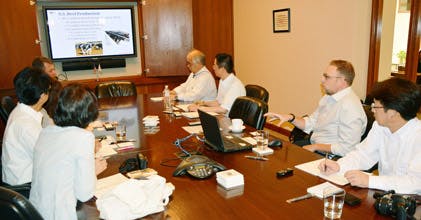Japanese Technical Journalists Get Look at U.S. Beef Industry, Disease Prevention

The team of Japanese technical journalists made a stop at Running Creek Ranch in Elizabeth, Colorado
To gain insight into the U.S. beef industry and learn more about prevention of animal disease and foodborne illnesses, a team of Japanese technical journalists recently visited USMEF, the National Cattleman’s Beef Association (NCBA), research facilities at Colorado State University (CSU) and cattle production operations in Colorado. Funding support for the team’s visit was provided by the Beef Checkoff Program and the USDA Market Access Program (MAP).
According to the journalists who met with USMEF Technical Services Manager Travis Arp in Denver, a small number of Japanese consumers cling to a bias against U.S. agriculture, though it is not the actual products that concerns them – it tends to be the technology utilized in the U.S and an overall lack of knowledge about U.S. beef production.
To that end, USMEF organized the team’s visit to showcase the beef industry, current disease prevention methods and U.S. agricultural research methods.
“The team met with a number of professionals who provided a firsthand look at the U.S. beef industry and its management structure,” said USMEF-Japan Senior Director for Technical Services Susumu Harada, who guided the team during its visit. “Those journalists on the visit evaluated highly the overall structure, including safety and prevention measures of animal disease and foodborne illnesses.”

USMEF Technical Services Manager Travis Arp (second from right) speaks with technical journalists from Japan about U.S. beef production
At USMEF, Arp discussed the structure of the U.S. beef industry – where and how cattle are fed and slaughtered. John Hinners, USMEF assistant vice president for industry relations, explained the role of USMEF and its work in all aspects of the international marketing of U.S. red meat.
During the team’s visit to NCBA headquarters in Centennial, Colorado, Josh White, NCBA’s executive director of producer education, presented the organization’s Beef Quality Assurance (BQA) Program. BQA is a national program that provides guidelines for beef production and raises consumer confidence by detailing proper management techniques and fostering a commitment to quality within each segment of the beef industry.
Harada said the presentation and follow-up discussion held at NCBA was especially helpful because it provided details of actions taken during past major foodborne illness and BSE outbreaks.
“The discussion confirmed to the team that the U.S. beef industry, in cooperation with the U.S. government, research institutes, the Centers for Disease Control and other agencies take great precaution and make immediate efforts to communicate on issues,” said Harada.
A tour of CSU’s research and experimentation facilities in Fort Collins, Colorado, included a look inside the school’s veterinary teaching hospital. There, the Japanese journalists witnessed practical uses of technology for prevention and treatment of animal diseases.
Visits to Colorado cattle operations included the Running Creek Ranch in Elizabeth and the Silver Spur Ranch in Elbert. Running Creek has been raising Limousin cattle since 1979 and is said to have registered more Limousin cattle than any other seedstock producer. Silver Spur, a multi-site ranch, is one of the top 10 commercial cattle operations in the country.
“The ranch visits helped give the team confidence that U.S. cattle producers have detailed management practices that address the concerns of the Japanese general public,” Harada said. “Learning about the BQA program went hand-in-hand with that notion, further confirming the efforts of U.S. producers.”
